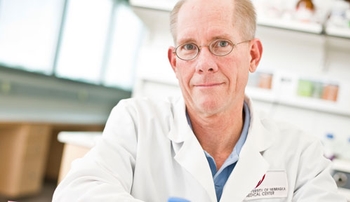The call came at about 3:30 p.m. Eppley Institute researcher Judy Anderson was on her way to watch her boss, Tony Hollingsworth, Ph.D., accept the award as UNMC’s 2011 Scientist Laureate. Then the phone rang.
It was Karen Taylor, research nurse coordinator, department of surgery. Karen has her own ringtone, because her calls can signal urgency, tragedy, opportunity: A patient has just died.
………
 |
Tony Hollingsworth, Ph.D., and his pancreatic cancer research team benefit from the efforts of their one-of-a-kind rapid autopsy program. |
………
She could hear the cacophony in the background.
Was Dr. Hollingsworth actually trying to get out of the Scientist Laureate award ceremony?
Yes. He was.
………
Dr. Hollingsworth’s team investigates pancreatic cancer. They are assisted by donors who died from the disease and pledged to give their organs and tissue to advance research. At the autopsies, the team wears protective equipment, works purposefully. Everyone has a job.
It takes two to three hours and about a dozen people take part. They work quickly to preserve the priceless gift the patient has given, quickly, to get the decedent back to the funeral home. Organs and tissue are removed, photographed, processed for research purposes, archived, stored. This particular type of tissue banking is unique to UNMC.
The team is trying to figure out how cancer kills patients. They collect clues.
………
As his team scrambled to ready the morgue, Dr. Hollingsworth walked with his family — his daughters, mother and brother were in town for the big day — to kill time before the ceremony. He wore a tie. Lab mates who have known him for years can count on one hand the times they’ve seen him in a tie.
In his acceptance speech, he put his team’s names up on the big screen. This award is really about them, he said. But they couldn’t be here. There had been a call …
………
Dr. Hollingsworth’s team is lucky. They know, really know, why they work. Most cancer researchers work with cell lines and tissue samples. They work in the abstract. But those in the Hollingsworth lab study how cancer invades a person; they investigate disease progression.
They observe moments of silence.
They know: Someone died from this.
………
They were almost finished with the rapid autopsy when the phone rang. Karen’s ringtone.
They had about an hour before a second rapid autopsy would start. Dr. Hollingsworth came in for that one. By the time he got there, the tie was long gone.
Awesome article!
Compelling story about amazing work and dedication.